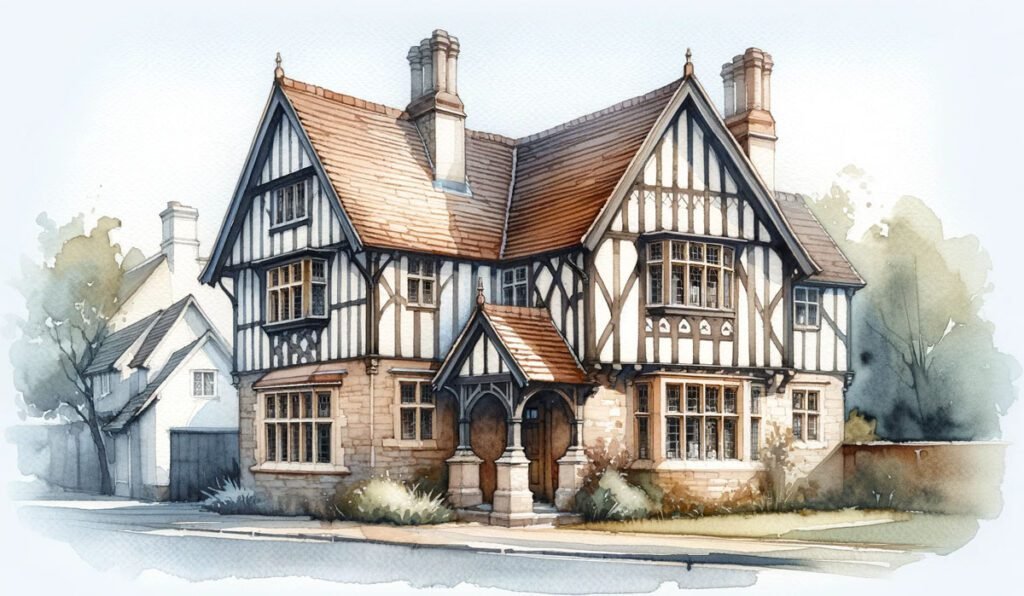Unlocking the Charm of Tudor Architecture
Imagine stepping into a storybook world, where houses are more than just structures but tell tales of history and style. Welcome to the enchanting realm of Tudor architecture, a design genre that takes us back to a period rich in history and character.
When Did Tudor Style Flourish?
Tudor-style homes had their heyday from about 1485 to 1603, during the Tudor period in England. Interestingly, their popularity experienced a revival in the United States and other parts of the world during the early 20th century, particularly between the 1890s and 1940s. This revival, often referred to as Tudor Revival or Mock Tudor, breathed new life into a style deeply rooted in history.
Identifying the Tudor Style
So, how do you spot a Tudor-style house? Here are some key features to look for:
- Steeply Pitched Roof: Tudor homes are famous for their steep, gable roofs. These roofs are not just visually striking; they were practical in rainy England, allowing water to flow off quickly.
- Timber Framing: One of the most iconic features is the exposed timber frames. They create a distinctive ‘black-and-white’ appearance as the spaces between the wooden frames are filled with plaster, brick, or stone.
- Tall, Narrow Windows: These homes often feature tall, narrow windows, frequently grouped together. They’re usually adorned with leaded glass, adding to their historical charm.
- Massive Chimneys: Tudor homes often have large, ornate chimneys, which were essential in the cold English climate. These chimneys often feature decorative chimney pots, adding to the house’s character.
- Tudor Arches: Look for doorways and windows with a gentle point at the top – these are classic Tudor arches.
What Makes Tudor Homes Unique?
Tudor homes have a storybook quality that makes them instantly recognizable. Their quaint and charming aesthetic evokes a sense of whimsy and enchantment. They conjure images of cozy, medieval cottages, even when found in modern neighborhoods. Their distinct appearance, characterized by a mix of medieval and Renaissance influences, gives them a timeless appeal.
Interesting Facts About The Tudor Style
- Origins of the Name: The style is named after the Tudor dynasty, which included notable monarchs like Henry VIII and Elizabeth I. However, many features of what we now consider “Tudor” architecture were developed before or after the Tudor period.
- Gardens and Surroundings: Many traditional Tudor houses feature lush, elaborate gardens, which are a staple in many fairy tales. These gardens, with their maze-like hedges and blooming flowers, complement the architectural style and add to the fairy tale imagery.
- Witch Marks: In some Tudor houses, especially in rural areas, you might find carved symbols known as ‘witch marks.’ These were believed to ward off evil spirits and were often found near fireplaces, windows, and doors.
- Glass Windows: During the Tudor era, glass windows were a luxury. In early Tudor houses, windows were often small due to the expense of glass. However, as the technique of glass-making improved, windows became larger and more common.
- Chimneys: The Tudor period saw a significant shift in the design and use of chimneys. They became more elaborate and were often a status symbol. Before this period, many homes would have had a simple central hearth.
Embracing the Tudor Style
Tudor-style homes are more than just buildings; they are pieces of history that continue to enchant us. Whether you’re strolling through a historic neighborhood or dreaming up your own fairytale home, the Tudor style offers a unique window into the past that continues to capture our imaginations.
Next time you spot a house with steep gables and timber frames, take a moment to appreciate the rich heritage it embodies. Remember, every Tudor home has a story, and it’s waiting for you to discover it.

